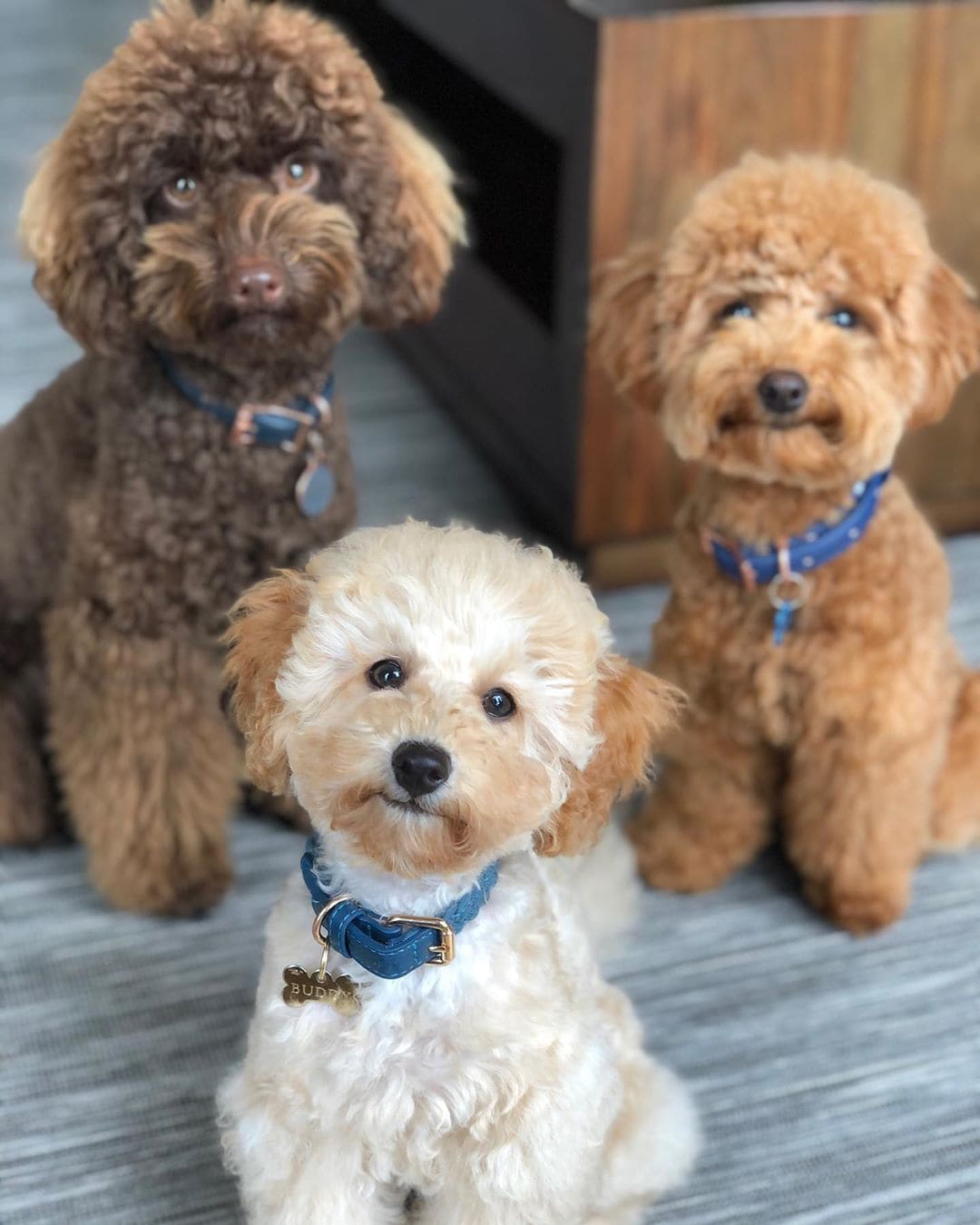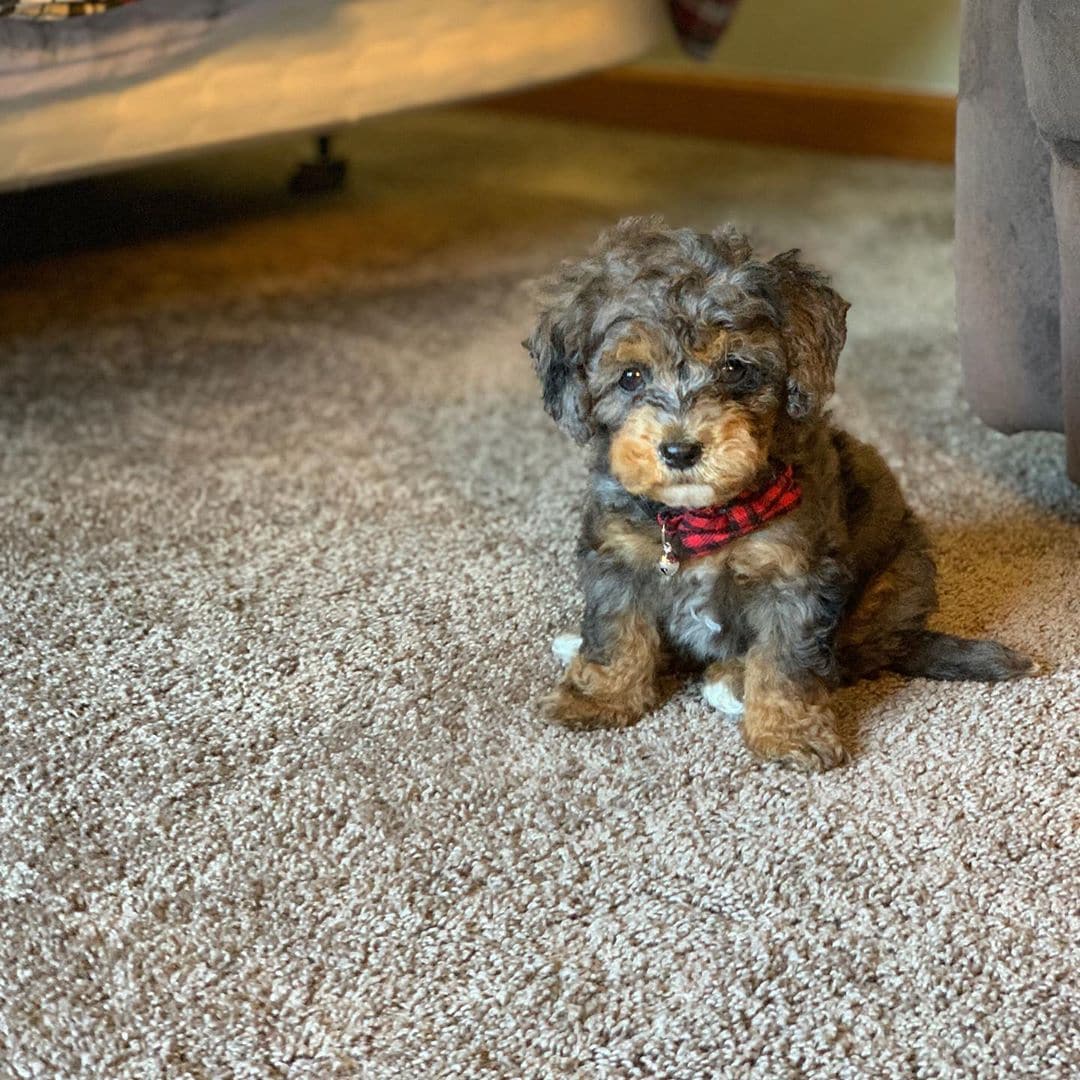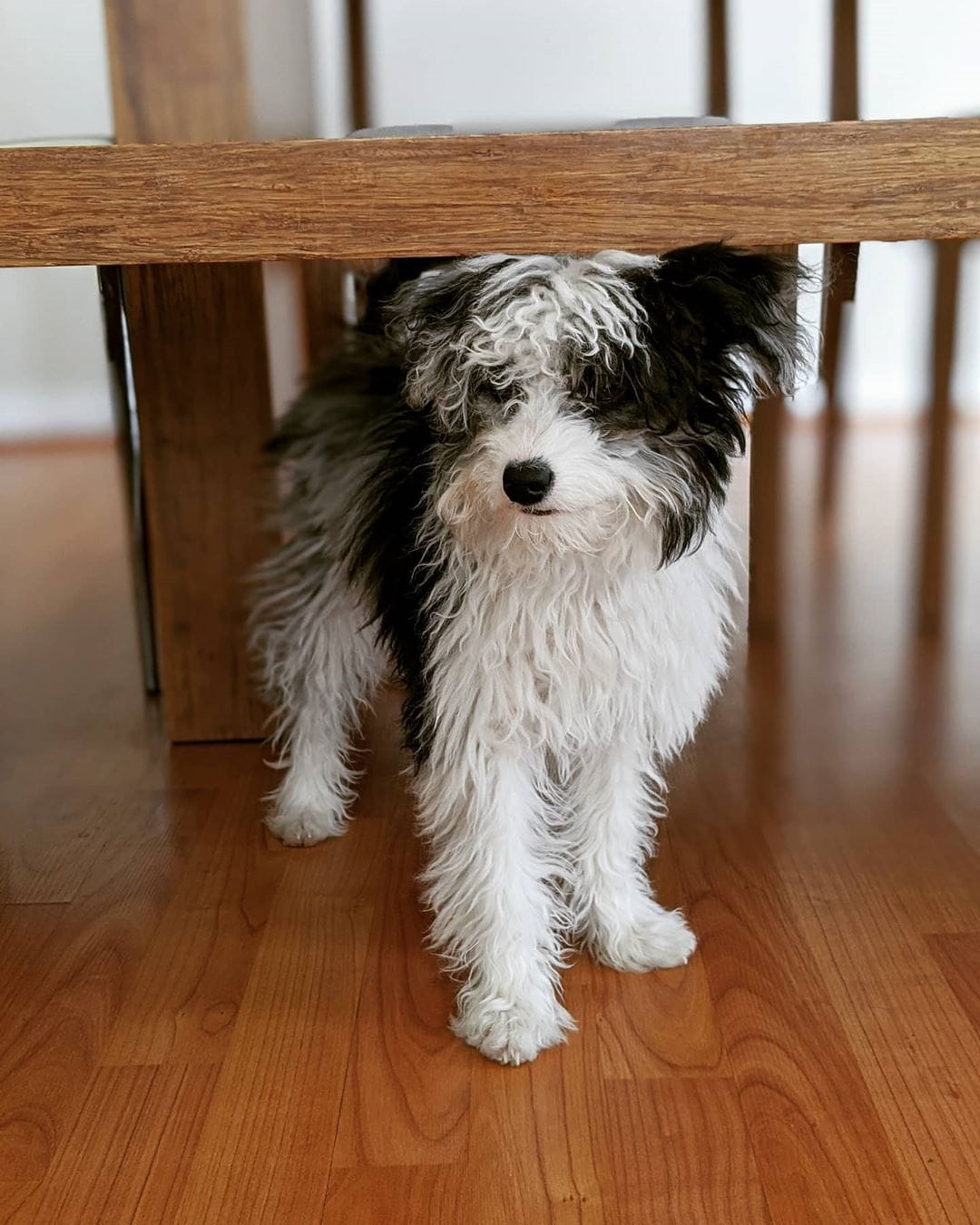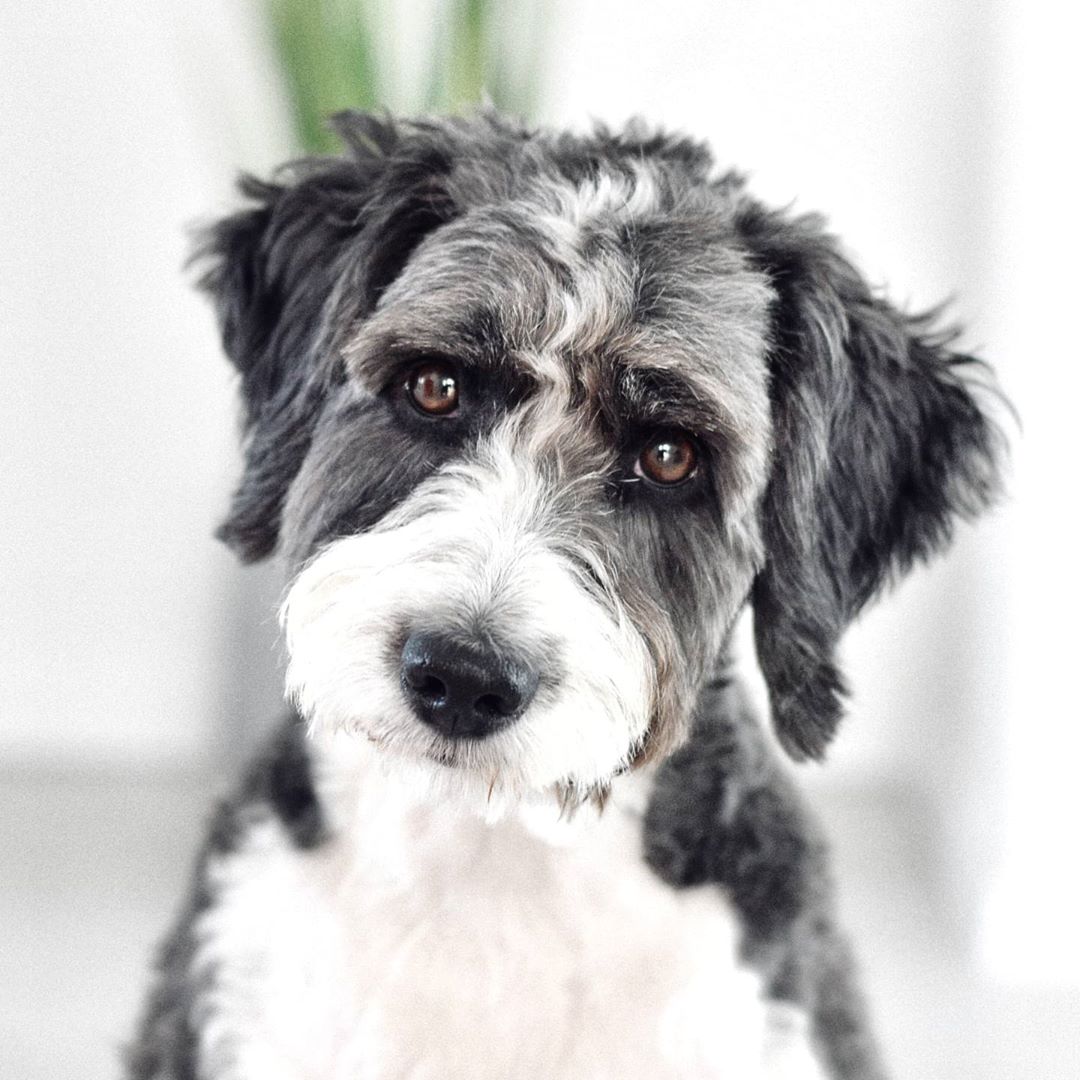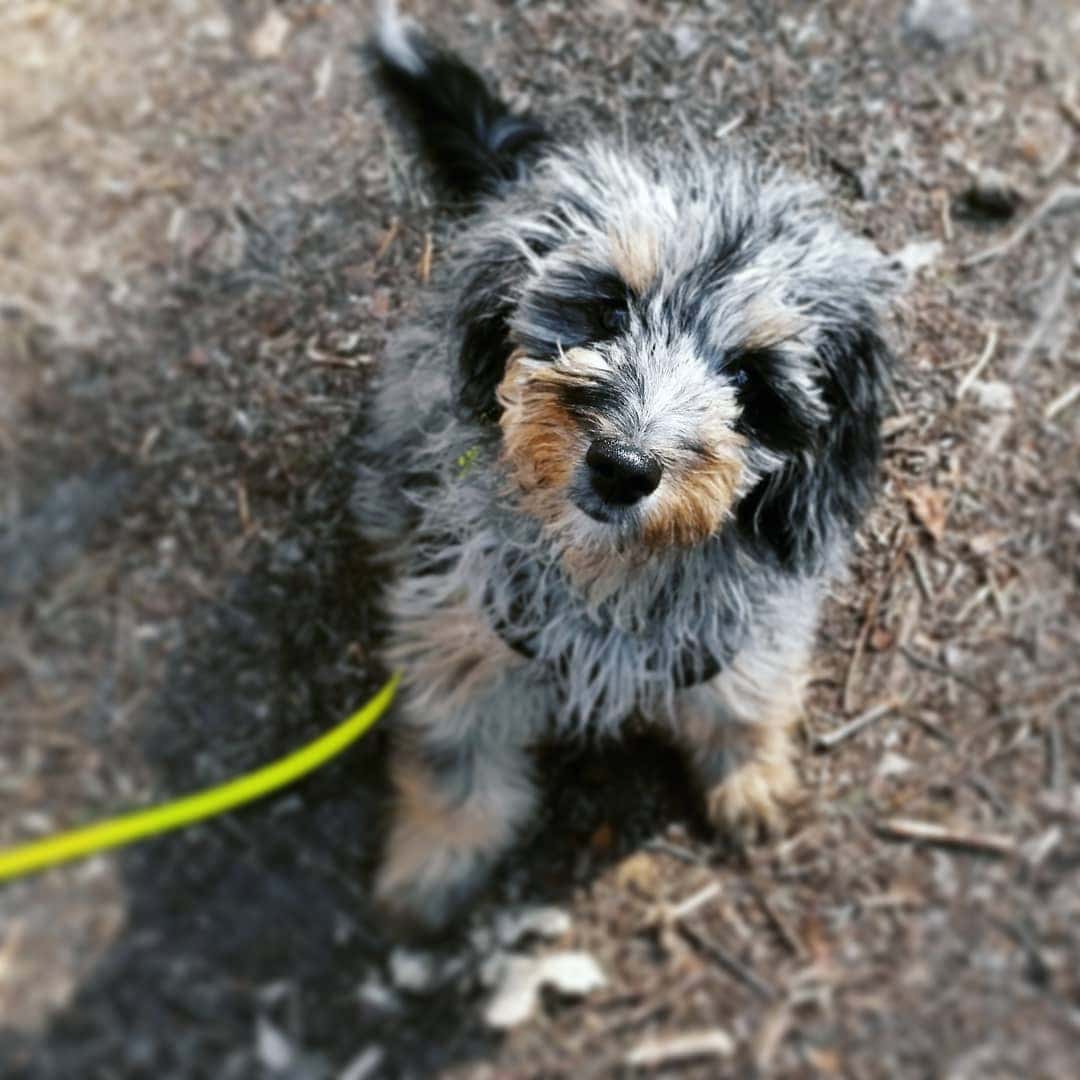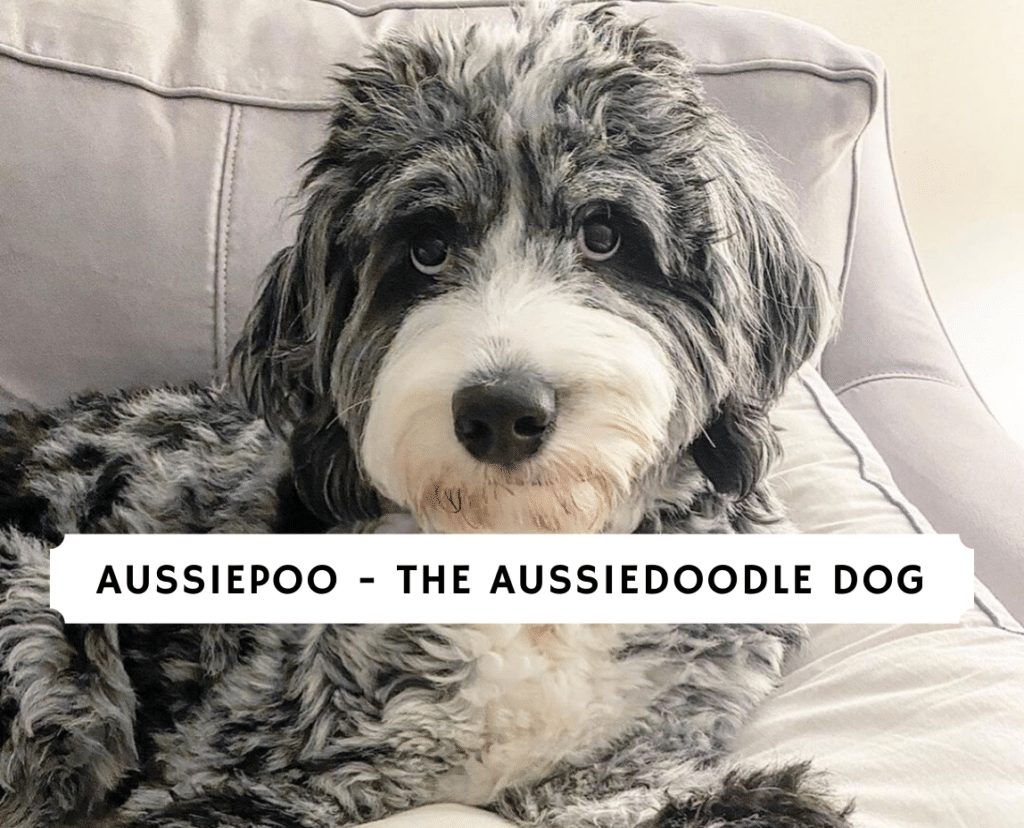
Aussiepoos, also commonly referred to as Aussiedoodles, are a small to medium-sized dog breed that’s a cross between an Australian Shepherd and Poodle. This is one of the fastest growing, trending doodle dog breeds because the Aussiepoo is largely hypoallergenic and low-shedding.
These fluffy haired dogs come in a rainbow of colors, and they’re super smart! The Aussiepoo makes a great family dog due to his intelligence and trainability. The pups love to run and play, so be prepared to get some exercise!
The great thing about Aussiedoodles is that they inherit traits from each parent. For instance, while the Australian Shepherd sheds – a lot – the Poodle does not. Your Aussiepoo is less likely to leave hair around your house. The Poodle is regal and loyal while the Australian Shepherd is playful and sometimes aloof. Your Aussiepoo will inherit a combination of these traits.
Some other Doodle mixes you might be interested in reading about are the Huskydoodle, or Chow Chow Doodle. But if you’re ready to learn more about the Aussiedoodle, read on!
Table of Contents
ToggleWhat is an Aussiepoo?
Aussiepoos have a ton of different nicknames, including the Aussiedoodle, Australian Shepherd Poodle mix, Aussiepoo, or Aussiedoo. Aussiepoos are fluffy balls of high energy and come from breeding the Australian Shepherd and Poodle together.
When you first think of this Australian Shepherd Poodle mix, it does not make much sense to combine these two different dog personalities together. However, the Aussiedoodle has superior genetic traits in that it is low shedding, great for dog owners with pet allergies, and typically the coat is a couple of colors with the most common being the blue merle Aussiedoodle. In addition, the Aussiepoo has a great personality that is nonaggressive, extremely intelligent, family friendly, and highly trainable.
Aussiedoodle History
Aussiedoodles don’t have an extremely detailed history, but it’s likely this hybrid breed started in the early 2000s as a way to combat the shedding issues of the Australian Shepherd. We do know that Aussiedoodles started after the first Goldendoodle was bred in the 1980s to help provide service to blind pet owners with allergies to pets. However, the purebred Australian Shepherd and Poodle have extremely long histories by themselves.
Australian Shepherd History
In the mid-19th century, people from the Pyrenees areas of Spain and France came to America with herding and shepherding dogs. These American ranchers bred these types of dogs as livestock herders in the midwest. The Australian Shepherd breed gained popularity after being featured in several Western movies and television series post-World War II.
Australian Shepherds were first recognized by the AKC in 1991 and the mini Australian Shepherd was accepted by the Club in 2012. The word “Australian” shepherd is believed to have come from workers who also brought dogs to America after working in Australia. Interestingly, Australian Shepherds are not recognized in Australia as an official dog breed.
Australian Shepherds typically range in height from 18 to 22 inches and weigh 40 to 60 pounds. There are actually several variations of Australian Shepherd coat colors, including blue merle, red merle, black and red. Most of the Australian Shepherd coats have white and tan markings.
Poodle History
The Poodle is among the most popular dog breeds in the world — 5th most popular dog breed according to the AKC. This is primarily because they are one of the most intelligent dog breeds and they don’t shed fur. The origins of the Poodle are usually widely debated on whether or not they originated from Germany or France. However, we do know that the Poodle was used for water activities and other agility exercises. Because the Poodle became so popular, breeders started making several different sizes and color combinations.
The Standard Poodle has long legs and stands between 20-23 inches and weighs 40-60 pounds. There is also the Toy Poodle and Miniature Poodle, each of which are used to make smaller variations of dogs like the Toy Aussiedoodle or Mini Aussiedoodle.
The Aussiepoo Breed
The Poodle and Australian Shepherd are both popular dogs around the world which causes them to be bred in a variety of colors and sizes. The Aussiedoodle will come in several standard sizes, including the Toy Aussiedoodle, Miniature Aussiedoodle, and Standard Aussiedoodle. In addition, Poodles come in ten standard colors and Australian Shepherd comes in four standard colors, making their coloration difficult to predict. In general, the majority of Aussiepoos that you see at the dog park will stand approximately 19 inches tall and weigh roughly 40 pounds. More information about the Aussiedoodle sizing is below.
How Big do Aussiedoodles Get?
In short, there are three standard sizes of Aussiedoodles including the Toy Aussiedoodle (less than 20 pounds), the Mini Aussiedoodle (between 20 to 30 pounds), and the Standard Aussiedoodle (over 30 pounds). More information about the sizing is below.
Toy Aussiedoodle
The Toy Aussiedoodle is the smallest of this Australian Shepherd Poodle mix. They typically stand around 15 inches tall and weigh between 15 and 20 pounds. The Toy Aussiedoodle is commonly bred by crossing a Toy Poodle and a mini Australian Shepherd. This is one of the most sought-after sizes of Aussiedoodle, but they do tend to have more underlying health issues than a Standard Aussiedoodle due to the genetic “toy” defect. However, the Toy Aussiedoodle is great for people who live in smaller and more confined spaces. Typically the smaller dog you have, the less exercise it will require.
Mini Aussiedoodle / Miniature Aussiedoodle
The Mini Aussiedoodle is the second smallest size of the Australian Shepherd and Poodle mix. They typically are around 17 to 18 inches tall and weigh 20 to 30 pounds. Thirty pounds may seem large, but miniature doodles are classified by a weight that’s under 30 pounds. Since the mini Australian Shepherd became an official dog breed recognized by the AKC in 2012, the mini Aussiedoodle has become more and more popular. The mini Aussiedoodle is typically bred between a Mini Poodle and a Mini Australian Shepherd in order to get a smaller dog. If you live in a condo or apartment, the mini Aussiedoodle would be a much better choice than a Standard Aussiedoodle. In general, though, Aussiepoos are high-energy dogs.
Standard Aussiedoodle
The Standard Aussiedoodle is the largest of the Australian Shepherd and Poodle mix. This dog is classified as anything over 30 pounds and usually stands around 20 to 22 inches in height. This dog will require a significant amount of exercise so make sure that you live an active lifestyle or have a backyard where this dog can run around in.
Aussiedoodle Colors
Poodles come in 10 standard colors (white, black, brown, blue, gray, silver, cafe au lait, silver beige, cream, apricot, and red), while the Australian Shepherd comes in four standard colors (blue merle, red merle, black and red). This makes the Aussiedoodle color difficult to predict. However, we do know that the merle coloring is known to be a dominant trait which is why so many Aussiepoos are multicolored in a merle pattern. However, it’s impossible to 100 percent accurately predict which color Aussiedoodle will be born due to the infinitely many different combinations. The best indication is to understand what the parent Australian Shepherd and parent Poodle look like.
The most common Aussiedoodle colors are Blue Merle Aussiedoodle, Red Merle Aussiedoodle, Black Aussiedoodle, and Chocolate Aussiedoodle. We will explain more below:
Blue Merle Aussiedoodle
A Blue Merle Aussiedoodle is bred with a signature Blue Merle Australian Shepherd and typically a lighter colored Poodle like white or cream. The Blue Merle Aussiedoodle coloring is a dominant genetic trait, so it typically supersedes any coat color of the Poodle. The blue merle pattern is typically a mix of blue, white, and tan colors that creates patches of these colors throughout the dog’s body. The Blue Merle Aussiedoodle is one of the most desired colorings of the Aussiepoo. The merle gene can also affect the dog’s eyes or skin color.
It should be noted that breeding two Blue Merle Aussiedoodles together should never be permitted. There are severe health issues when breeding two merle dogs together, which can result in blindness or deafness.
Red Merle Aussiedoodle
The Red Merle Aussiedoodle is a dog that is red, white, and tan in color. The Red Merle Aussidoodle is typically bred from a Red Merle Australian Shepherd and a white or cream-colored Poodle. In general, since the merle gene is a dominant trait, the coat color gets passed on to the various Aussiepoo offspring. In addition, you will see Red Merle Aussiedoodles with all sorts of eye coloring, including brown, blue, green, or two different eye colors. The Red Merle Aussiedoodle is the second most sought-after coloring behind the Blue Merle Aussiedoodle.
Black Aussiedoodle / Chocolate Aussiedoodle
The other two most common colors of the Aussiepoo are the Black Aussiedoodle and Chocolate Aussiedoodle. Almost always, a majority of the Aussiepoo’s body will be covered in a solid black or chocolate and you will see white patches typically in the chest area of the dog. The Black Aussiedoodle and Chocolate Aussiedoodle are typically bred from a darker-colored Poodle and a darker-colored Australian Shepherd. In general, the Black Aussiedoodle and Chocolate Aussiedoodle are more “rare” colors, but less sought after because the colors aren’t distinct enough to determine the dog breed.
Is the Aussiepoo the Right Dog for Me?
With proper socialization, the Aussiepoo is a great family dog and gets along with anyone as long as they are socialized as a puppy. On the downside, the Aussiepoo requires tons of attention in terms of physical and mental activities. Both the Australian Shepherd and Poodle are active dog breeds that like to run, walk, and keep busy. Without proper exercise, the Aussiepoo is likely to become destructive around your home as they become “bored.” This oftentimes leads to disobedience and mischievous activities like chewing on shoes or other objects. It’s good to consider mental stimulation like chewing on horns or dog puzzles. If you don’t live an active lifestyle or aren’t willing to accommodate the physical lifestyle of a dog, then you should probably consider another dog breed that is less active.
The Australian Shepherd and the Poodle are lovely dogs, but there are benefits to the Aussiedoodle. The Aussiedoodle is going to be mostly hypoallergenic, which means that you will suffer fewer pet allergies. In addition, an Aussiedoodle will shed a lot less fur than a normal Australian Shepherd, which means less vacuuming and cleaning. The downside to a nonshedding dog is that you will have to regularly groom them and give them haircuts every 8 to 12 weeks. In addition, you’ll have to brush your Aussiedoodle at least a few times a week to prevent tangles and mattes from occurring.
In general, both the Poodle and Australian Shepherd are considered healthy dog breeds so an Aussiedoodle should live well over 10 years. If you aren’t worried about having the perfect purebred dog, an Aussiepoo certainly makes a good choice for someone with an active lifestyle that likes going outside. It also helps that your Aussiedoodle will likely be the cutest dog on the block!
Conclusion for Aussiepoo – The Aussiedoodle Dog
At the end of the day, only you can choose whether or not the Aussiepoo is the right dog for you. However, we can tell you that the Aussiedoodle is one of the fastest-growing doodle dog breeds because they are multicolored, fluffy, affectionate, and intelligent. In addition, this dog breed is great for families and children because they are non-aggressive. Considering the superior genetic qualities of being mostly hypoallergenic and nonshedding, you can’t really go wrong with this dog breed. Just know that it is relatively unpredictable what color, personality, and temperament your dog will have since this is a crossbred dog. They will either take after the Australian Shepherd or Poodle, but it’s unknown which traits will be dominant and which will be recessive.
Frequently Asked Questions
Do Aussiedoodles Shed?
In general, you should plan on your Aussiedoodle shedding at least a little bit. The amount your Aussiedoodle sheds is going to be highly dependent on the amount of Poodle genetics that your dog has since the Poodle is nonshedding. As a rule of thumb, you can expect that if you get an F1 Aussiedoodle (50% Australian Shepherd and 50% Poodle) then it will shed at least a little bit of fur. If you get an F1B Aussiedoodle (25% Australian Shepherd and 75% Poodle) they will virtually be nonshedding. If you want to read more about the various generations of doodles to decide which ones will be nonshedding, you can read our guide called Labradoodle Generations: F1, F1B, F2, F2B, & F3.
Are Aussiedoodles Hypoallergenic?
In general, the Aussiedoodle will be mostly hypoallergenic. This is because the Aussiedoodle inherits genetic traits from the Poodle. The more Poodle genetics that your dog has, the more hypoallergenic they will be.
Are Aussiedoodles high maintenance?
The dogs are smart, easy to train, and loving as can be. They’ll require a lot of exercise, however, and grooming your pup regularly is a must. Plan to give your Aussiepoo at least an hour of exercise each day. Additionally, you’ll want to ensure that you brush his fur every day to every other day to keep tangles and mats at bay.
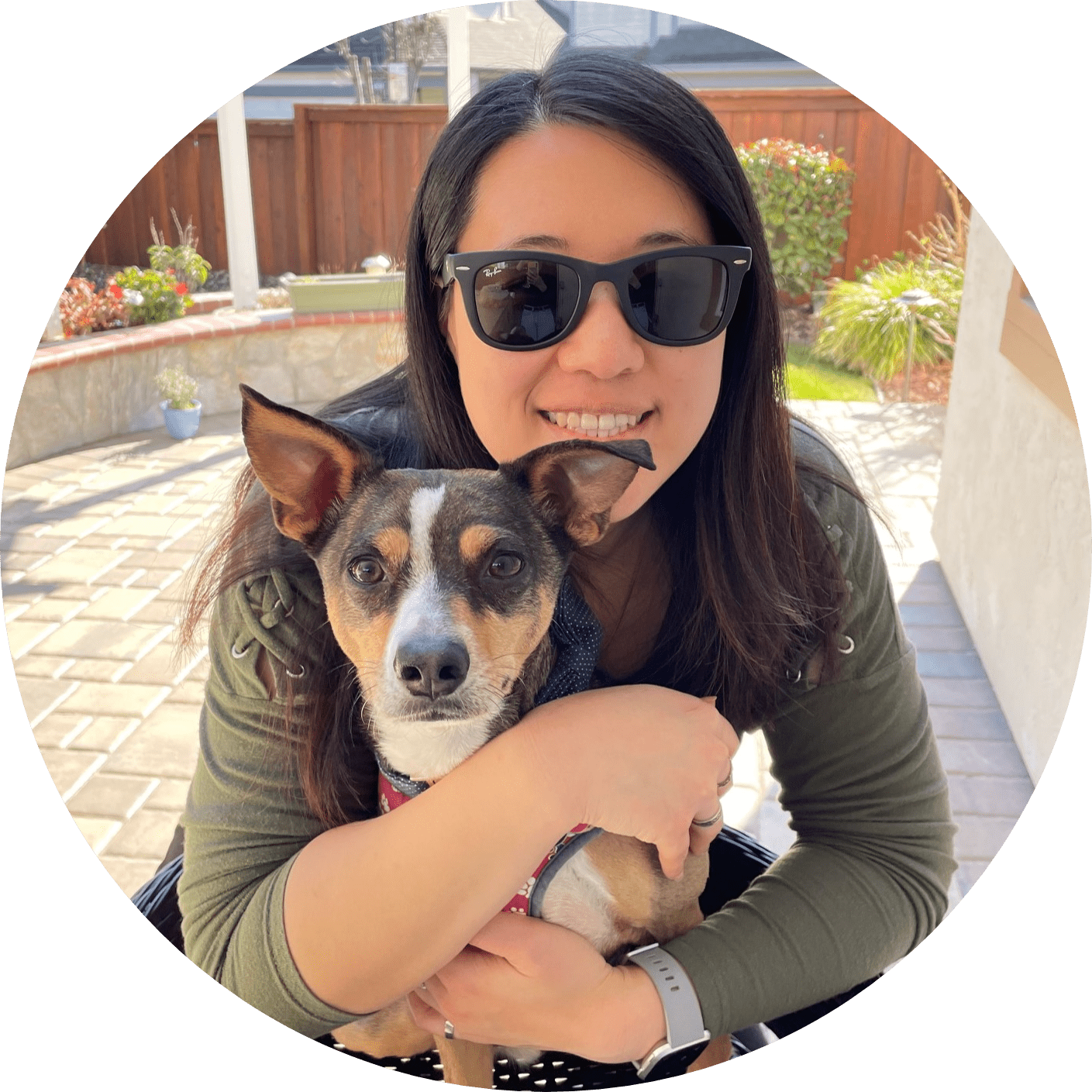
Dr. Sabrina Kong graduated from the Royal Veterinary College in England in 2016 and has been working at a small animal clinic in Northern California since then. She grew up in the Bay Area and got her bachelor’s degree from Cal Poly San Luis Obispo. She also became a Certified Canine Rehabilitation Practitioner through a program at the University of Tennessee.
When she isn’t in the clinic taking care of her four-legged patients, she enjoys traveling and trying new foods with her friends and her three-legged dog, Apollo. She adopted Apollo from her clinic when he was a puppy with numerous health issues. Dr. Kong truly cares about taking care of animals.


